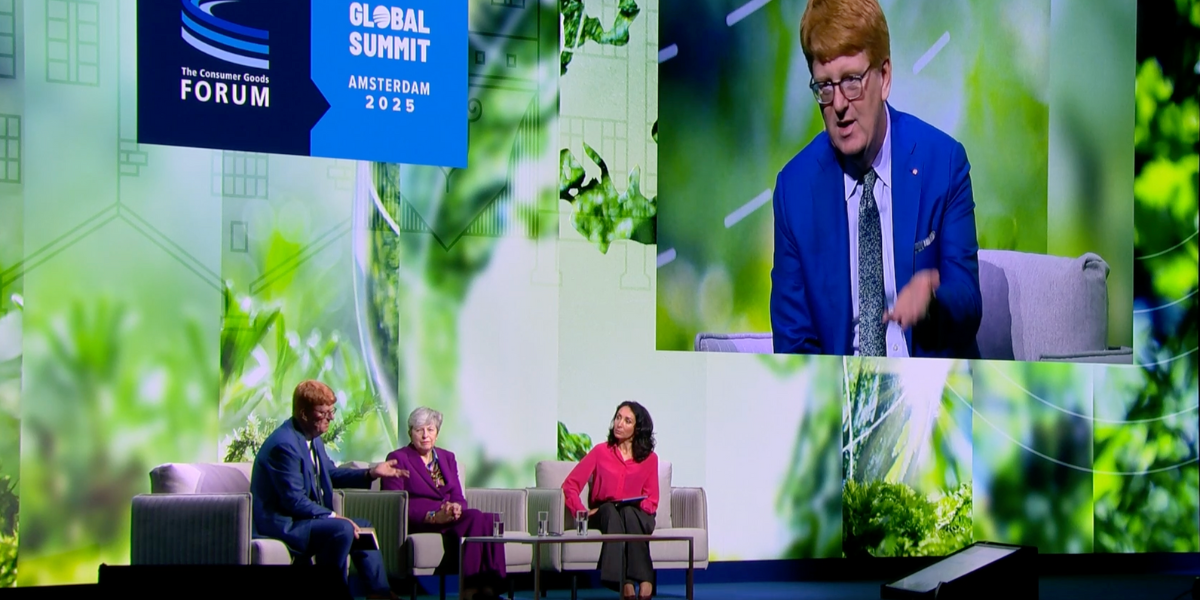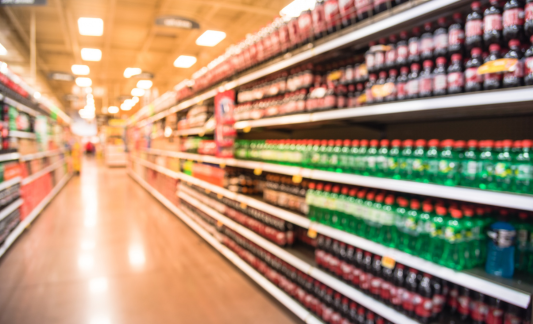Help Isom IGA recover from devasting floods

Over the past few years, the grocery industry has wrestled with rising prices and ever more price-sensitive shoppers. From the spike in costs during the pandemic to the emerging risk of tariff-induced cost increases, inflation has reshaped how we stock our shelves and serve our communities.
No conversation on raising the costs of goods is ever popular, and it’s especially unpopular in today’s climate given the massive increase in grocery prices since 2019.
But I want to talk specifically about the human cost of low-cost goods — especially when those goods are produced with exploited labor, debt bondage, or outright slavery.
IGA CEO John Ross and Rt. Hon. Theresa May Discuss Modern Slavery & Human Trafficking at the CGF Global Summit 2025
What Lies Behind the Low Price?
We’re all accustomed to looking at margin lines. We know how to analyze freight, packaging, and wholesale cost. But how often do we ask, “How much of the price I pay is tied to someone else’s suffering?”
To answer that we must look at the math, and it is shocking:
- An estimated 50 million people globally are trapped in modern slavery, including 27.6 million in forced labor.*
- Many of them are in the agriculture, fishing, and food processing sectors — the very industries that supply our stores.*
- Debt bondage, coerced migrant work, child labor, and unpaid overtime are common in the upstream stages of goods like seafood, cotton, corn, cocoa, and coffee.*
To put these numbers into perspective, at the height of biblical slavery, 2000 BC, a couple million humans were likely enslaved. Since 2016, we have added more than that each year in forced labor, debt bondage, and child work slavery. And yet, despite this hidden human toll, the actual cost savings gained from these exploitative practices are shockingly small.
Slavery is increasingly part of our modern supply chain for a lot of reasons. War, famine, and other natural disasters, local persecution, and economic pressure have created migrant populations that are ripe for exploitation. And emerging global digital technology allows organized criminals to recruit, displace, and exploit workers with greater ease than ever before.
Globalization is also a factor. Worldwide demand for ever cheaper products inadvertently incentivizes suppliers to exploit workers — especially in the replication of raw material or agricultural goods where their role in food production is removed from the production of finished goods.
The less visibility to brands and retailers, the more likely there is some form of human exploitation. From shrimp peeling sheds in India and the Far East — where children are sold into slavery so developed nations can get frozen peeled shrimp at cheaper prices — to migrant workers brought illegally into the U.S., forced to work long hours and live in appalling conditions to pay off the fees they paid exploiters to smuggle them into the country, modern slavery is increasingly more pervasive and ever closer to home.
And how much does this reliance on enslaved workers actually save? Let’s look at just one example: frozen shrimp. Manual labor is the smallest part of the actual cost of goods.
Even if we doubled or tripled wages for the most vulnerable workers in our food system, retail prices would rise by only pennies per pound or unit.
In most cases, labor exploitation accounts for less than 4% of the final price, while logistics, marketing, and markup account for the rest.
It is hard to talk right now about any practice that would raise prices — our shoppers are hurting, inflation has made staples feel like luxuries, and current policies in Washington are more likely to raise prices than reduce them. And yes, value perception is everything at the shelf. But here’s the truth:
Exploitation doesn’t make food meaningfully cheaper. It just makes the cheapest part of the process crueler.
How Can Our Values Influence the Food Supply Chain?
As an industry, independent grocers and our suppliers are principled companies. Many of us have a value statement similar to “respect for all people” as our operating code. Does this just apply to our employees, or should it stand for everyone involved in putting food on the table?
We also must face a hard reality here at home: undocumented workers power much of U.S. food production. They pick fruits and vegetables, work in slaughterhouses, and process our poultry and dairy. Without them, farms stall and prices spike.
As Immigrations and Customs Enforcement (ICE) crackdowns increase, many of us are deeply uncomfortable — because we know these workers are not villains. They are often exploited, unpaid, and unprotected, yet indispensable.
In the long run, we must also ask:
Is a food system that relies on people who have no legal rights or protection truly sustainable, or even ethical?
I believe immigration reform, while painful and imperfect in its current enforcement, is morally right if it leads to a legal, protected, fairly paid agricultural workforce. An ethical solution is to build a system that allows legal immigrants to work without threat of deportation, that allows businesses to raise wages legally, improve labor conditions, and dismantle modern slavery at home.
The problem with the immigration dialogue in the United States today is that no one is talking about the right issues. Organized crime isn’t coming from farm workers and undocumented people working in poultry plants; it comes from the criminals and exploiters that brought these workers into the country illegally, who confiscate their documents and hold them in debt bondage, paying debt that they will never be able to pay off. And it’s in the buyers who don’t look, don’t ask, and don’t hold their supply chain to a moral standard.
In the U.S. we do have a legal system for seasonal and non-citizen workers, the H-2A Visa, but it’s not accessible or adequate for many farmers or workers. It’s highly bureaucratic, lacks permanent protection, and leaves both growers and laborers vulnerable. Modernizing an existing legal system not only solves ongoing demand for farm and food production labor, but it neuters the exploiters. Legal immigration reduces human trafficking and drains organized crime of power. In other words, we don’t need to send undocumented farm workers back as criminals; instead, we need to document, legalize, and control inflow.
What can independent retailers do?
As retailers, we have an obligation to understand our role in ending modern slavery.
- Know your supply chain. Ask your suppliers: Where is this produced? Who’s picking, peeling, or packing it?
- Ask your legislator for reform. The answer to illegal immigration and ending human trafficking sits in existing, though dated, legislation. We need H-2A Visa reform, which is a step toward a fair and dignified food economy.
- Ask your legislator to enforce the Robinson-Patman Act. Created in 1936 to prevent price discrimination, this law now goes unenforced, allowing sellers to offer different prices to different purchasers of the same goods. It hurts independent retailers, benefits national chains, and drives prices lower and therefore encourages more unethical labor practices.
If slavery were eliminated from the food system today, the price of the products in our stores might increase by a penny or two. Can we really say those cents are more important than someone’s freedom, safety, or dignity?
As grocers, we know cost matters. But so does conscience. Let’s not settle for a food system built on hidden suffering. Let’s build one worthy of the communities we serve.
What can brands & larger companies do?
In 1996, Life magazine ran a picture of a barefoot child stitching soccer balls in a country where poverty-driven child labor was common. Those balls had a Nike logo on them, and Nike and many other global manufacturers were called out for enabling human trafficking, their sales and stock prices suffering. That was 1996.
For those of us in the grocery industry, children in faraway impoverished countries making toys for affluent children in developed nations seems far away from the grocery industry. And yet, the sad truth is, the number of humans (including children) in economic bondage has more than tripled since then, much driven by the global food industry itself.
No one wants to find their brand or store on the front page of a publication. But in order to ensure we aren’t a part of the problem, it means we need to make understanding our own supply chains a priority. And that starts with the CEO.
- First step, make ending human slavery in the food industry a C-suite objective. If it is important to you, it will be important to your teams and suppliers.
- Second, tell people! Put it on paper, and in your annual objectives that ending human trafficking in the grocery business is important to you.
- Third, assign someone on your team to be the key leader and connect that person with the Human Rights team at the Consumer Goods Forum (CGF). CGF is a global industry association which works to end hunger, human trafficking, reduce plastic waste, and more. Every global CPG and global retail CEO sits on their board. They have a huge list of resources, and can help whoever you assign to this effort be successful and in turn lower your risk. be a force for good in an increasingly risky world.
If we as retailers say that slave labor is unacceptable, our suppliers will do the same to their supply chain. A force of will here can become a force of good in ending human trafficking in our industry, and set Food Retailing as a model for other industries to follow.
*Sources: USDA Economic Research Service Report, University of Michigan Seafood Vaue Chain breakdowns, Corporate Accountability Lab (2023–2024).
You May Also Like
These Stories on From the Desk of
Dec 18, 2025 9:32:36 AM |
3 min read
Dec 10, 2025 4:57:50 PM |
1 min read


No Comments Yet
Let us know what you think